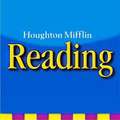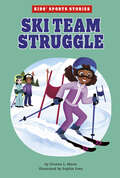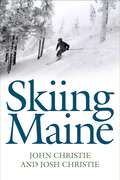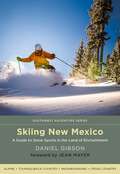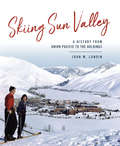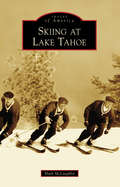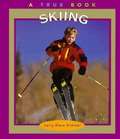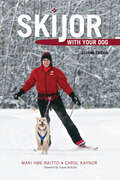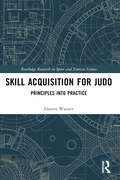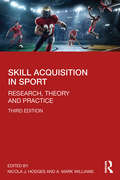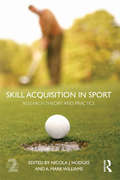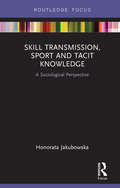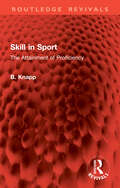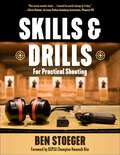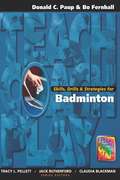- Table View
- List View
Skating to Fame (Houghton Mifflin Harcourt Vocabulary Readers #Leveled Reader: Level: 5, Theme: 2.1)
by Lee S. JusticeAn introduction to ice skating and famous ice skaters.
Skeeter Hill Rascals
by James O. JenkinsA group of boys learn the Skeeter Hill Recreation Department plans to expand Junior League instead of Little League. Consequently the sandlot players realize they will not have an opportunity to play together on a team next season. Led by Willie Wince the boys embark on a journey inspired by their desire to play Little League baseball together. The boys hatch a plan to fight City Hall and change their minds. The execution of the imaginative plan causes outrage in the town of Skeeter Hill. The ingenious plan causes a big stir leading up to the fall town hall meeting encouraging a charismatic coach to surface and volunteer to coach Willie and his friends. Since the Junior League is not expanded, Garvin and his buddies must play another year on a Little League team. They suspect Willie and his friends for the turn of events and harbor ill will toward them. The two teams play the season on a collision course. One team plays underhanded and dirty to win. The other team resorts to pranks and trickery to claim victory. Which team will win the season championship during the Fourth of July weekend?
Ski Soldier: A World War II Biography
by Louise BordenThis true-life adventure story tells the story of Pete Seibert, a ski soldier severely wounded in World War II, who went on to found the Vail Ski Resort in Colorado. <P><P>Ever since he first strapped on his mother’s wooden skis when he was seven, Pete Seibert always loved to ski. At eighteen, Seibert enlisted in the U.S. Army and joined the 10th Mountain Division, soldiers who fought on skis. In the mountains of Italy, Seibert encountered the mental and physical horrors of war. When he was severely wounded and sent home to recover, Seibert worried that he might never ski again. But with perseverance and the help of other 10th Mountain ski soldiers, he took to the slopes and fulfilled his boyhood dream— founding a ski resort in Vail, Colorado. The immediacy of Louise Borden’s vivid text puts readers on the front lines with Seibert and his platoon. <P><P>This dramatic recounting of a World War II experience includes archival photos, as well as commentary on the legacy of the 10th Mountain Division, and a detailed list of sources.
Ski Team Struggle (Kids' Sports Stories)
by Dionna L. MannMaddie loves being on the ski team with her friend Sarah. Sarah is the fastest skier on the team. Maddie wants to beat Sarah’s time but is having trouble. She takes her frustrations out on Sarah. Will Maddie realize that she needs to stop comparing herself to others before she ruins her friendship with Sarah?
Skiing Maine
by Josh Christie John ChristieMaine Ski Hall of Famer John Christie, author of the definitive history of the resort at Sugarloaf and veteran of Maine's ski industry, teams up with his son Josh to guide skiers to all the best places. Every public ski mountain or hill in the state is listed, along with pertinent information about trails, amenities, conditions, and personal anecdotes and suggestions from the authors, who have skied at all of them. Included are destinations for cross-country and downhill skiing.
Skiing New Mexico: A Guide to Snow Sports in the Land of Enchantment (Southwest Adventure Series)
by Daniel GibsonThis invaluable book tells you everything there is to know about skiing and snowboarding in the Land of Enchantment, with thousands of helpful details on the state&’s downhill ski resorts and cross-country and backcountry venues.Each ski area is profiled in a separate chapter, including details on facilities and services such as childcare and instructional options; statistics like average snowfall, vertical drop, and lift capacity; transportation options, including shuttle and bus services; and prices of lift tickets, rental equipment, and lessons. Gibson also includes historical facts about each ski area and its founders, suggestions for best runs by type of terrain, activities off the slopes, and notes on his favorite places to stay and eat. Separate chapters on cross-country and backcountry downhill skiing are equally informative.
Skiing Sun Valley: A History from Union Pacific to the Holdings (Sports)
by John W. LundinUnion Pacific Railroad's Averell Harriman had a bold vision to restore rail passenger traffic decimated by the Great Depression: create ski tourism in Idaho's remote Wood River Valley. A $1.5 million investment opened Sun Valley in December 1936 with a lavish lodge, luxury shopping, Austrian ski instructors and extensive backcountry skiing. Prestigious tournaments featured the world's best skiers. Chairlifts invented by Union Pacific engineers serviced skiers quickly and comfortably. Ski instructor and filmmaker Otto Lang recalled that seemingly overnight, it became "a magnet for the 'beautiful people,' a meeting place for movie stars and moguls, chairmen and captains of industry, Greek shipping tycoons, and peripatetic playboys--and playgirls--of the international social set." After World War II and Harriman's departure, Union Pacific's willingness to pay the $500,000 yearly subsidy waned. Bill Janss purchased it in 1964 and reimagined it as a year-round resort but lacked the capital for growth. Sinclair Oil owners Earl and Carol Holding acquired it in 1977, revitalizing it into a premier resort with international status. Award-winning ski historian John W. Lundin celebrates America's first destination ski resort using unpublished Union Pacific documents, oral histories, contemporaneous accounts and more than 150 historic images.
Skiing at Lake Tahoe (Images of America)
by Mark MclaughlinOrganized ski racing in America started near Lake Tahoe in the 1860s when gold miners rode 15-foot boards that reached speeds near 100 miles per hour. By 1895, residents of Truckee had started the nation's first winter carnival west of the Rocky Mountains and soon built the largest ski jump in California. Today's Lake Tahoe, with significant annual snowfall, has become home to the largest concentration of ski resorts on the continent. Places like Mount Rose, Squaw Valley (home of the 1960 Winter Olympics), Sugar Bowl, Heavenly Valley, Homewood, Sierra-at-Tahoe, Alpine Meadows, Kirkwood, Diamond Peak, Donner Ski Ranch, Granlibakken, and Northstar-at-Tahoe have seen skiing styles, sports, and fashions churn through the decades, while now gone resorts, such as Edelweiss and White Hills Ski Resort, echo the memories of yesterday's skiers through the pines.
Skiing in Colorado (Images of Sports)
by Colorado Snowsports Museum and Hall of Fame Dana MathiosSkiing in Colorado evolved from a transportation necessity to a world-class recreational pursuit. The first documented use of skis in Colorado occurred in the winter of 1859. As the popularity of the activity grew, ski resorts opened throughout the state. After World War II, Colorado saw a boom in the industry along with advancements in equipment, lifts, and safety; the development of ski schools; and the opening of new ski areas. This volume includes photographs from the Colorado Snowsports Museum that illustrate and celebrate the history of skiing in Colorado.
Skiing in Olympic National Park
by Roger Merrill OakesWith its glaciated peaks, temperate rain forests, and ocean wilderness, Olympic National Park has been called three parks in one. Efforts to protect and preserve these treasures began with the creation of a federal reserve in 1897, followed by a national monument in 1909, and then Olympic National Park in 1938. The 1920s and 1930s saw the building of many trails, shelters, and roads. In 1934, the US Forest Service completed a primitive road to the summit of Blue Mountain, affording skiing at Deer Park, and in 1957, the National Park Service completed an improved road to Hurricane Ridge. These two areas have offered alpine (lift-assisted) skiing to several generations. While these roads remain today, the recognition of the value of preserved wilderness has stopped road construction. In 1988, most of the park became federally designated wilderness. In 1981, Olympic National Park was designated a World Heritage Site.
Skiing in the Catskill Region (Images of Sports)
by George V. QuinnArriving by train to Phoenicia, New York, in the mid-1930s, downhill skiers first discovered the snowy trails of Simpson Ski Slope. Soon after, many Borscht Belt hotels were offering skiing and skating as ways to fill rooms during cold winter months when crowds thinned. In the high central Catskills, where abundant snowfall was a big draw, many abandoned rooming houses were commandeered to serve as base lodges for fledgling ski areas. In addition to farming and logging, skiing became an important industry to the area. People found steady employment in dozens of new areas sprouting all over the mountains. Downhill skiing is just part of the region's history. Ski jumping, racing, ski clubs, fashion, and colorful personalities were all part of the experience.
Skiing in the Mad River Valley
by Ellie Hilferty John HilfertyIn 1948, the first skiers to experience the steep and twisting downhill trails of Mad River Glen had to traverse muddy or frozen dirt roads to get to their destination. The warmth of a country inn was a comfort on those cold winter nights and continues as a hallmark of the Mad River Valley today. Even with the condo boom that developed after the opening of Sugarbush on Christmas Day in 1958, little has upset the ambience of the 20-mile-long valley. The valley developed a distinct personality, attracting "ski bums" who exchanged urban pressures for a laid-back lifestyle that continues today.
Skiing into Modernity
by Andrew DenningSkiing into Modernity is the story of how skiing moved from Europe's Scandinavian periphery to the mountains of central Europe, where it came to define the modern Alps and set the standard for skiing across the world. Denning offers a fresh, sophisticated, and engaging cultural and environmental history of skiing that alters our understanding of the sport and reveals how leisure practices evolve in unison with our changing relationship to nature. Denning probes the modernist self-definition of Alpine skiers and the sport's historical appeal for individuals who sought to escape city strictures while achieving mastery of mountain environments through technology and speed--two central features distinguishing early twentieth-century cultures.Skiing into Modernity surpasses existing literature on the history of skiing to explore intersections between work, tourism, leisure, development, environmental destruction, urbanism, and more.
Skiing into the Bright Open: My Solo Journey to the South Pole
by Liv ArnesenThe first woman to ski solo to the South Pole tells the story of what it took to get there At home in Norway it is eight o&’clock on Christmas Eve night, but ahead, at the Amundsen–Scott base that has been visible for hours, it is already early in the morning of Christmas Day when Liv Arnesen, after skiing solo for 745 miles in fifty days, finally arrives. She had been dreaming of the South Pole for most of her forty-one years, and now, even in her joy at having reached her goal in December 1994, she has to ask herself: what took you so long? In Skiing into the Bright Open Arnesen describes the exhausting, exhilarating experience of being the first known woman to ski unsupported to the South Pole. She also answers her own question, framing her account of her historic expedition with her longtime struggle to find the freedom and confidence to follow her dreams into uncharted territory. From her childhood in Norway to the seasons she spent working as a guide on Svalbard, the Norwegian archipelago in the Arctic Ocean, Arnesen courted the cold, and her memoir reflects the knowledge and passion for Arctic and Antarctic exploration that grew with her adventures in the wintry reaches of Norway and beyond. Tracing her path from the heroic stories of explorers like Fridtjof Nansen and Ernest Shackleton to her own crossing of the Greenland Ice Cap in 1992, Arnesen credits the inspiring feats of those who preceded her but also describes the obstacles—including niggling self-doubt—that tradition, convention, and downright prejudice put in her way as she endeavored to find the support and sponsorship granted to men in her field.A tale of solitary adventure in the bleak and beautiful bone-chilling cold of Antarctica, Skiing into the Bright Open tells a story of gritty determination, thrilling achievement, and perseverance in the face of near despair and daunting odds; it is, ultimately, an object lesson in the power of a dream if one is willing to pursue it to the ends of the earth.
Skiing with Henry Knox: A Personal Journey Along Vermont’s Catamount Trail
by Sam BrakeleyIn 2015, Sam Brakeley stood at a crossroads in his life. His long-time girlfriend was moving to Utah, with or without him, and he was torn between following her or remaining in New England with family, friends, and the land he loved. So he set out to complete the Catamount Trail, a 330-mile cross-country ski trail that runs across Vermont from the Massachusetts border to Canada. He took advantage of his time in the woods to reach a decision—and brought Henry Knox along for the trip. In 1775, Knox undertook a winter journey of similar length, retrieving dozens of artillery pieces from the recently captured Fort Ticonderoga on Lake Champlain and dragging them 300 miles through snow and cold to Cambridge, Massachusetts, to help George Washington drive the entrenched British army from Boston. Knox, too, faced his own challenges in love, leaving behind a young pregnant wife. By exploring Knox’s eighteenth-century physical and emotional journey while undertaking his own twenty-first-century trip on the Catamount Trail, Brakeley reminds us that history has many lessons to offer the living.
Skiing: A True Book
by Larry Dane BrimnerIllustrates the various styles of skiing, from cross-country to downhill, as well as kinds of equipment and clothing.
Skijor with Your Dog: Second Edition
by Mari Høe-Raitto Carol KaynorSkijoring, or being pulled on skis by a dog in harness, is a great sport in which almost everyone—and almost any breed of dog—can participate. It requires little beyond a pair of skis and a dog with a desire to pull. The second edition of this popular and practical guide to the sport covers what equipment is needed, how to teach a dog to pull, and how to work with your dog year-round. Although it is geared toward beginners, Skijor with Your Dog offers plenty of useful information for experienced skijorers as well, including racing tips, how to involve children, how to camp and travel with dogs, and how to train for competition. The book also covers canicross, bikejoring, and other ways to work with dogs when there’s no snow.With this book in hand, readers will have all the information they need to begin enjoying the outdoors with their dogs in a whole new way.
Skill Acquisition for Judo: Principles into Practice (Routledge Research in Sport and Exercise Science)
by Darren WarnerFirst introduced as an Olympic sport in Tokyo 1964, judo is a dynamic grappling sport where it’s competitors win by throwing and pinning their opponents to the floor or forcing submission through armlocks or strangles. To become an elite judoka, athletes are required to develop a high level of physical literacy before they're able to execute complex throwing techniques, delivered within physically intensive combative intervals. With over one hundred different throwing techniques, with variations of each, as well as ground holds, armlocks and strangles, the importance of motor skill development and decision making is extremely high. Skill Acquisition for Judo; Principles into Practice blends theory and application by chronologically establishing the theoretical foundations underpinning skill acquisition before exploring its impact on the developing judoka. The book bridges the gap between theory and applied practice, exploring insights into the training methods of judo coaches throughout the world, providing practical examples of applied ecological dynamics, manipulating training constraints to develop their athletes and deliver performance through the talent development pathway. Considering the impact that constraints led training has been shown to have on open skill performance sport, it’s application by judo coaches should come as no surprise considering the dynamic, open skill nature of the sport. This book creates a platform that explores the theoretical foundations of skill acquisition whilst providing insight into the training methods of judo coaches throughout the world, utilising and manipulating training constraints to develop their athletes and deliver performance. Skill Acquisition for Judo; Principles into Practice is key reading for students, coaches and practitioners in the fields of sport science, coaching, motor learning and skill acquisition as well as judoka themselves.
Skill Acquisition in Sport: Research, Theory and Practice
by A. Mark Williams Nicola J. HodgesSkill Acquisition in Sport gives academics, students, coaches and practitioners the broadest and most scientifically rigorous grounding in the principles and practice of the discipline. Fully revised, updated and restructured, the third edition integrates theory and practice, and provides more material on practical application than ever before. Divided into four sections—providing instruction and feedback, organizing effective practice, training high-level skills, and the theories and mechanisms underpinning skill acquisition practice—the book covers a full range of key topics, including: the role of errors and rewards in motor learning instructions and demonstrations, feedback and biofeedback imagery in motor learning constraints-based learning, self-directed learning, and learning from teaching technique change, creativity training, and visual gaze training practicing under pressure the neurophysiology of learning Based on the latest research, including chapters on emerging topics, and written by a global cast of world-leading experts, Skill Acquisition in Sport is an essential textbook for any kinesiology or sport science student taking skill acquisition, expertise development or motor learning classes.
Skill Acquisition in Sport: Research, Theory and Practice (2nd Edition)
by A. Mark Williams Nicola Hodges<p>Success in sport depends upon the athlete's ability to develop and perfect a specific set of perceptual, cognitive and motor skills. Now in a fully revised and updated new edition, Skill Acquisition in Sport examines how we learn such skills and, in particular, considers the crucial role of practice and instruction in the skill acquisition process. <p>Containing thirteen completely new chapters, and engaging with the significant advances in neurophysiological techniques that have profoundly shaped our understanding of motor control and development, the book provides a comprehensive review of current research and theory on skill acquisition. <p>Leading international experts explore key topics such as: <p> <li>attentional focus <li>augmented Feedback <li>observational practice and learning <li>implicit motor learning <li>mental imagery training <li>physical guidance <li>motivation and motor learning <li>neurophysiology <li>development of skill <li>joint action. <p> <p>Throughout, the book addresses the implications of current research for instruction and practice in sport, making explicit connections between core science and sporting performance. No other book covers this fundamental topic in such breadth or depth, making this book important reading for any student, scholar or practitioner working in sport science, cognitive science, kinesiology, clinical and rehabilitation sciences, neurophysiology, psychology, ergonomics or robotics.
Skill Transmission, Sport and Tacit Knowledge: A Sociological Perspective (Routledge Focus on Sport, Culture and Society)
by Honorata JakubowskaTeaching the skills necessary to play sport depends partly on transmitting knowledge verbally, yet non-verbal or tacit knowledge also has an important role. A coach may tell a young athlete to 'move more dynamically', but it is undoubtedly easier to demonstrate with the body itself how this should be done. Skills such as developing a 'feel for the water' cannot simply be transmitted verbally; they are embodied in the tacit knowledge acquired from practice, repetition and experience. This is the first sociological study of the transmission of skills through tacit knowledge in sport. Drawing on philosophy, sociology and theories of embodiment, it presents original research gathered from qualitative empirical studies of young athletes. It discusses the concept of tacit knowledge in relation to motor skills transmission in a variety of sports, including athletics, swimming and judo, and examines the methodological possibilities of studying tacit knowledge, as well as its challenges and limitations. This is fascinating reading for all those with an interest in the sociology of sport, theories of embodiment, or skill acquisition and transmission.
Skill in Sport: The Attainment of Proficiency (Routledge Revivals)
by B. KnappOriginally published in 1963, Skill in Sport was addressed to students and teachers of Physical Education, to coaches interested in the more theoretical aspects of their work, and to all individuals who wished to find out the best ways to acquire skill in any particular game or sport. Psychologists too may have found many of the examples and much of the discussion of interest to them.Practical issues are dealt with first and then the underlying theories are considered. Individual differences, teaching methods, motivation, specialization, differences between games and activities such as swimming and shot-putting, are among the problems which are discussed against a background of experimental evidence and personal experience. Many references are cited and many practical examples are given. The book sets out to stimulate discussion, more precise observation and research and it provides a sound basis on which to build a more complete understanding of skill and its attainment.Today it can be read and enjoyed in its historical context.
Skills and Drills: For Practical Shooting
by Ben StoegerElevate Your Shooting with Skills & Drills: For Practical Shooting—The Ultimate Training Manual Unlock the secrets to top-tier performance with Skills & Drills, the definitive livefire training guide from renowned shooting expert Ben Stoeger. Drawing on his remarkable experience and success at the highest levels of competition, Stoeger has meticulously refined his training methods into this groundbreaking manual. Skills & Drills represents the pinnacle of livefire training for USPSA/ISPC competitors. This comprehensive guide is packed with advanced drills and concepts designed to elevate your shooting skills to new heights. Dive into detailed practice tips that maximize every session, and explore insightful sections that pinpoint common mistakes and teach you how to correct them effectively. Whether you use Skills & Drills as a standalone resource or alongside Dryfire: Fundamental Shooting Techniques for Training at Home, you&’ll benefit from expert advice, advanced drills, and much more. Discover the path to becoming a top competitor with the most detailed and involved live-fire manual ever created.
Skills, Drills & Strategies for Badminton
by Don PaupThis book is part of the Teach, Coach, Play series, emphasizing a systematic learning approach to sports and activities. Both visual and verbal information are presented so that readers can easily understand the material and improve performance. Built-in learning aids help readers master each skill in a step-by-step manner. Using the cues, summaries, skills, drills, and illustrations will help build a solid foundation for safe and effective participation now and in the future. The basic approach in all of the Teach, Coach, Play activity titles is to help readers improve their skills and performance by building mastery from simple to increasingly complex levels. The books strive to illustrate correct techniques and demonstrate how to achieve optimal results. The basic organization in each book is as follows: Section 1 overviews history, organizations and publications, conditioning activities, safety, warm up suggestions, and equipment. Section 2 covers exercise or skills, participants, action involved, rules, facility or field, scoring, and etiquette. Section 3 focuses on skills and drills or program design. Section 4 addresses a broad range of strategies specifically designed to improve performance now and in the future. Section 5 provides a convenient glossary of terms.
